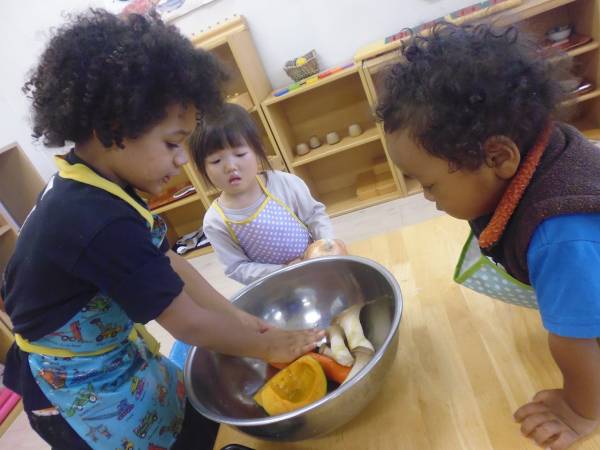“You gotta eat your vegetables.” This mantra, uttered by concerned mothers since the time of Alexander the Great, has led to tears, tantrums, and arguments. I suspect it may have even started the careers of many a stage magician (Hey Mom, see? The vegetables are all gone!).
Vegetables Don’t Have to Be Boring
For some reason, parents have determined eating vegetables means the veggies must be presented in as bland and unappealing a manner as possible. But who in their right mind actually wants to eat cauliflower that has been boiled in unsalted water for ten minutes, then plopped on the upper left quadrant of the plate like some sort of mass from outer space?
“By preparing in advance and relaxing your ideas of what vegetables are supposed to taste like, you will open up a whole new world of possibilities for the simple vegetable.”
We as parents spend so much time making intricate and sexy main dishes (usually the protein-heavy portion of our meal), that by the time we get to the side dishes, we have little time and energy left to spare. I understand, too. After a long day of work, afternoon activities, and everything else that goes on during the day, sometimes you just don’t have the time to think creatively. But trust me, it’s not that hard.
Here are some hints before we begin
- Involve your kids in the preparation as much as you can. As I mentioned in a previous article, when you let them in on the creative process, they’ll want to sample what they produce. Let them cut, chop, manipulate switches, or do whatever else it is they can safely do to get involved.
- Use spices, herbs, and judicious amounts of other ingredients. Does it mask the real flavor? Of course it does. But so does adding salt and pepper to your beef, or Thai chili sauce to your chicken.
So let’s tackle a few recipes, shall we? Try some of the following recipes and ideas to get your kids eating their veggies, and perhaps even asking for more.
RELATED: 6 Tips on Making Healthy Eating for Kids Not So Difficult
Avocado Chocolate Pudding
This one is devious. I mean, avocado? In dessert? Yep, and best of all, it can make for an awesome pudding. Avocado is rich in vitamins and healthy fats. These fats are the perfect emollient for whipping into a pudding. Now, this isn’t low calorie, and if you are carb-conscious you’re going to have to use some sort of sugar substitute. However, it is an easy and tasty way to get vegetables and vitamins into a diet.

Enjoying avocado chocolate pudding.
To prepare, take one or two dark chocolate bars and melt them down with a hint of butter. I’ve used different ratios of cocoa and sweetener to avocado, so experiment to find your own preference. Once your chocolate is all melted into a beautiful shiny syrup, blend it together with one avocado and a pinch of cinnamon in your blender or food processor for about thirty seconds. Put it in your refrigerator for about an hour, and presto-chango, delicious pudding!
- The Vegan Version: For a vegan option, you can substitute out the butter and chocolate bars and use cocoa powder, coconut milk, and the sweetener of your choice to taste.
- The Bodybuilder Version: Throw in your favorite protein powder, but beware the gritty texture.
Oven-Roasted Squash
When most kids think of squash, grimaces are not far behind. However, many of the members of the squash family make delicious sweet bites when they are roasted. Two of my favorites are kabocha pumpkin squash and butternut squash.
“Involve your kids in the preparation as much as you can… [W]hen you let them in on the creative process, they’ll want to sample what they produce.”
To prepare, thoroughly clean out the insides of your gourd, then cut into chunks about half-inch square. I try to remove the flesh from the outer shells, although here in Japan, you can find the shells attached through all sorts of preparations, including frying, roasting, boiling, and stewing. For children however, I have found that shell-less roasted gourd goes over a lot better than shell-on.
To cook, lightly salt the squash squares and roast in a 375-degree oven until they begin to caramelize on the edges.

My students preparing squash for roasting.
Thanksgiving Pumpkin Smoothies
This one lends itself to not only the sweet-toothed of us, but also the lazy. I will admit to having used pre-packaged pumpkin for this recipe. But before you light your torches and sharpen your pitchforks, be aware that it was organic pumpkin, with nothing else added. Since that first time, I have also re-made this recipe using more commonly available commercial canned pumpkin (think the stuff you might use in a pumpkin pie for the office Thanksgiving potluck) and using roasted, blended, and mashed kabocha pumpkins.
“Adding vegetables into our children’s diets is of utmost importance. But as these recipes show, we don’t have to sacrifice flavor in the pursuit of healthy variety.”
To make the smoothies, take a few spoonfuls of mashed pumpkin (however you obtained it), and blend it with other smoothie ingredients. As I have no problems with dairy products, I use semi-frozen milk, along with honey and cinnamon. To make it thicker, I tend to add more pumpkin, although that does play with the flavor.
I’ve also seen people use coconut milk, almond milk, goat milk, and just about every other milk under the sun, with good results. One athlete I was working with who was trying to add weight used half-and-half with protein powder, but I personally disliked the texture and found it too heavy in my stomach.
Give It a Shot
Adding vegetables into our children’s diets is of utmost importance. But as these recipes show, we don’t have to sacrifice flavor in the pursuit of healthy variety. In fact, by preparing in advance and relaxing your ideas of what vegetables are supposed to taste like, you will open up a whole new world of possibilities for the simple vegetable.
Photo 1 courtesy of Shutterstock.
Photos 2 and 3 courtesy of David Varnes.






